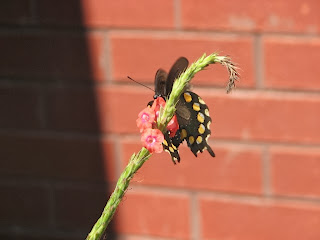This has been insect month at our home.
It all started with our Gulf Fritillaries. One day, 15 of them emerged from their chrysalids!
.jpg) |
| emerging Gulf Fritillaries |
.jpg) |
| emerging Gulf Fritillaries from the same day |
.jpg) |
| beautiful emerging Gulf Fritillary with the probiscis clearly seen |
 |
| dry and ready for life as a butterfly. A newly emerged Gulf Fritillary nectars on Porterweed. |
Since then, we have been looking for insects in our yard. We have some goldenrod blooming in the back of our yard, so we have gone out every day to investigate the insects on it. And there have been a wide variety of native bees, flies, and wasps. They are really hard to photograph! The goldenrod moves. The insects move. And none of them like having the cameras right in their faces.
But it has been amazing to watch! Such diversity! Such a wonderful feeling of ecosystem!
We decided to paint concrete stepping stones with the 4 stages of a butterfly development.
Then, in what I think is the coup de gras, we had our first ever pipe vine swallowtail. It stayed for almost an hour nectaring at our Porterweed.
 |
| Pipe Vine Swallowtail at the Porterweed |
 |
| My middle daughter was able to touch it gently without it even moving. |
 |
| The youngest had to try it, too. Same result. |
 |
| Another view of the Pipe Vine Swallowtail |
 |
| hummingbird moth |
affiliate link
I am submitting this entry for the Outdoor Hour Challenge with Barb of Handbook of Nature Study.

.jpg)
I am amazed. What a delight to see them emerge! Your stepping stones are just wonderful, too. Attractive AND educational!
ReplyDeleteIt really was a delight to see the butterflies emerge! Thanks.
DeleteThank you for sharing your amazing insect discoveries with the OHC Blog Carnival. I loved seeing every image and your stepping stones are an awesome way to cement their lifecycle into our brains. I so enjoyed your entry!
ReplyDeleteThank you, Barb. My son said (at the end of this month, and after this post), "I SO love insect month! It may be my favorite study all year!" We owe a lot to you for all you do to support nature studies!
DeleteI love that quote from Einstein...it's so true.
ReplyDeleteThank you. I do, too. :)
DeleteCristy, I apologize for this comment being totally unrelated to your post, but I wanted to let you know you've won the three book giveaway I hosted on my blog at GoExploreNature. Congratulations! Please send me your contact information so we can get the Travels with Gannon & Wyatt books out to you right away. I'm at tdj2004 at gmail dot com.
ReplyDelete